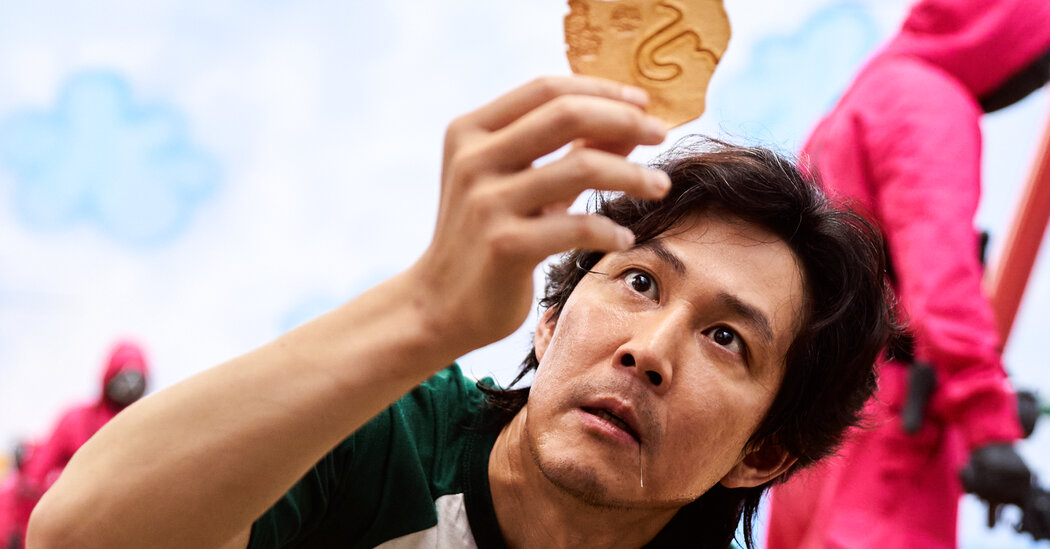
Netflix’s ‘Squid Game’ Reinvigorates Dalgona Candy

Interest in the South Korean treat has spiked since the debut of the Netflix drama “Squid Game.”

One of Maddy Park’s earliest memories of street food was when vendors set up a portable stove outside her elementary school in Seoul, South Korea, to sell a candy for about a dime. It was part sweet treat, part game.
Candy makers melted sugar and frothed it up with a pinch of baking soda to make this dalgona candy, Ms. Park recalled. They then pressed the mixture flat and pushed shapes like a circle, triangle, square, star or umbrella into the center. Ms. Park’s classmates determinedly tried to pick out the stamped shape using a needle without breaking it — a game called ppopgi. If the children successfully removed the shape from the brittle candy, they won another treat for free.
“Dalgona was one of the cheapest, unhealthiest, yet the most addictive gamble for 7-year-old me,” said Ms. Park, now 28 and living in Downtown Brooklyn, N.Y.
Ms. Park is one of many Koreans whose memories of dalgona candy, also called ppopgi, have surfaced thanks to the release last month of “Squid Game” on Netflix. The fictional series follows a group of cash-strapped people willing to die playing childhood games for a chance to win a jackpot. Episode 3 is all about ppopgi.
Read more about “Squid Game” on Netflix.
“There’s a gambling sort of element to it, kind of like in the ‘Squid Game’ but without life or death,” JinJoo Lee, 55, the Korean food blogger behind Kimchimari, said about ppopgi. Her recipe for dalgona candy, which she posted online in 2018, has had a 30 percent increase in traffic in the past few days. Similar candies are popular around the world, she said, but they go by different names.
Dalgona candy filled a sweet void in postwar South Korea for children who had grown accustomed to the free chocolates given away by American soldiers, said Albert Park, an associate professor with expertise in Korean history at Claremont McKenna College in Claremont, Calif. Dalgona was inexpensive and accessible, he said.
At first, glucose was used because raw sugar was expensive, Mr. Park said. But vendors likely began using sugar after the Korean War, when companies began to process it from its raw form, he said. The toffee-colored honeycomb candy became common in the 1960s, and was sold outside elementary schools and toy stores.
Dalgona vendors started to disappear in the early 2000s as online shopping became more popular and toy stores began to close, Mr. Park said. It’s also likely that South Korea’s booming candy industry, and its proliferation of other types of inexpensive candies, put many of the mom-and-pop dalgona candy makers out of business.
Image
But because of the popularity of “Squid Game,” the candy has made a comeback as a retro, nostalgic snack, Mr. Park said. “For some of these young Koreans, I don’t think they consciously think it’s Korean candy, but it’s a way to connect to their history that they don’t want to necessarily do in a history book,” he said.
Social media has shepherded its leap to worldwide fame, introducing the candy to people outside South Korea.
The name dalgona became more familiar to Americans in the midst of the coronavirus pandemic because of the popularity of the whipped coffee also known as dalgona. The beverage gained fame in January 2020 after the actor Jung Il-woo tried it in Macau on “Stars’ Top Recipe at Fun-Staurant,” a South Korean television show. He said it reminded him of the dalgona candy, unofficially naming the drink in the process. It then feverishly spread to South Korea’s coffee shops and eventually made its way to the United States.
Some people, though, say dalgona candy’s spread through social media can divorce it from its cultural significance. “Dalgona candy is representative of fetishizing K-pop and K-dramas, and seeing one thing and saying, ‘Wow I’ve discovered Korean culture,’” said Nancy Wang Yuen, a sociologist and expert on race and racism in Hollywood, “when in fact the candy, the cinema, the television series, all of these things, have been in existence.”
Fans love the candy’s blend of bitter, nutty and sweet tastes. “The flavor, for some reason, stays with you,” said Annie Yoo, 46, of Düsseldorf, Germany.
Ms. Yoo’s most vivid memories of South Korea are those of foods like dalgona candy, as she was only 6 years old when she immigrated to the United States. She remembers the dirt roads she took to get to the dalgona street vendors under their tarps.
“I really miss that candy,” she added. “In the midst of all the stuff we were going through, you barely get any treats. It was really magical.”
In a YouTube video in which the “Squid Game” cast reacts to some of the scenes, Chae Kyung-sun, the show’s art director, reveals that dalgona candy was the trickiest prop to work with. Behind the scenes, she said, there was a professional who kept making the candy as they were filming.
Those who have played the candy game approach it with different strategies. Hwang Dong-hyuk, the show’s writer and director, incorporated his own into the series: The show’s main character, Seong Gi-hun, repeatedly licks the candy to loosen the umbrella shape from the middle. It’s a trick the director said he used to win prizes when he was younger.
But Ms. Park, who ate the candy outside her elementary school in Seoul, never did manage to win a free candy.
Source: https://www.nytimes.com/2021/10/05/dining/squid-game-netflix-dalgona-candy.html

















